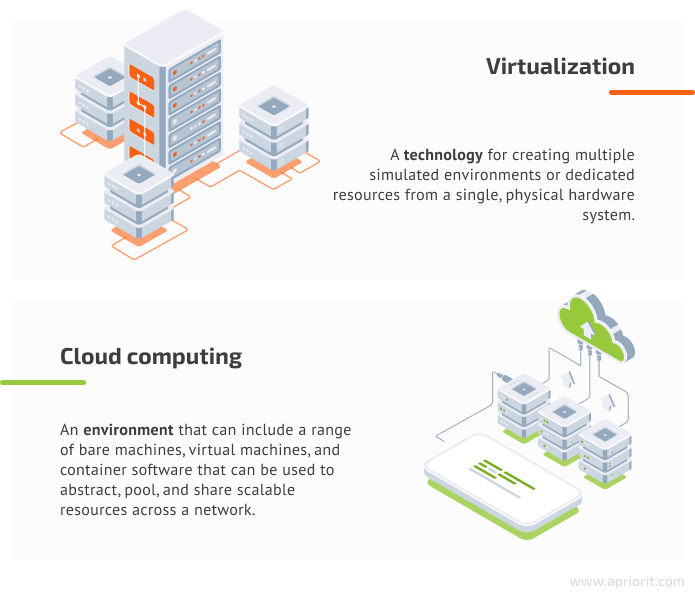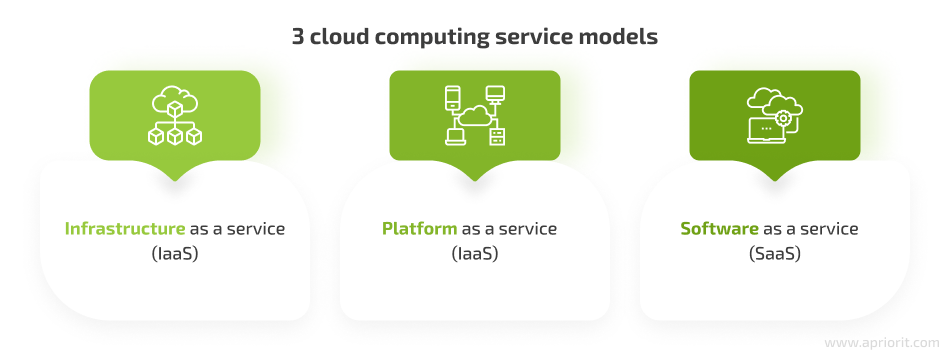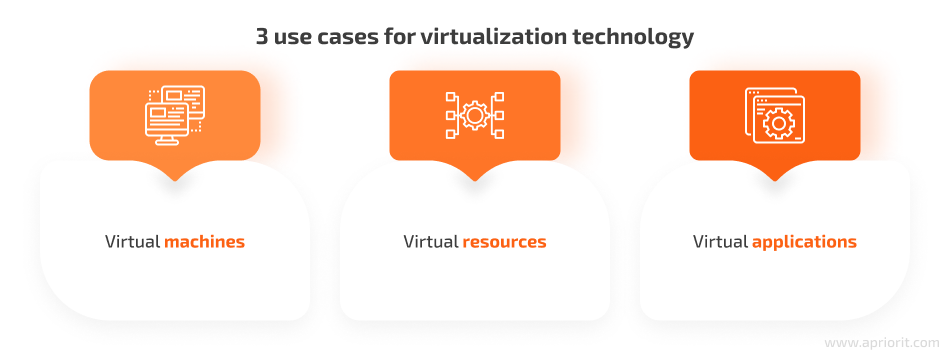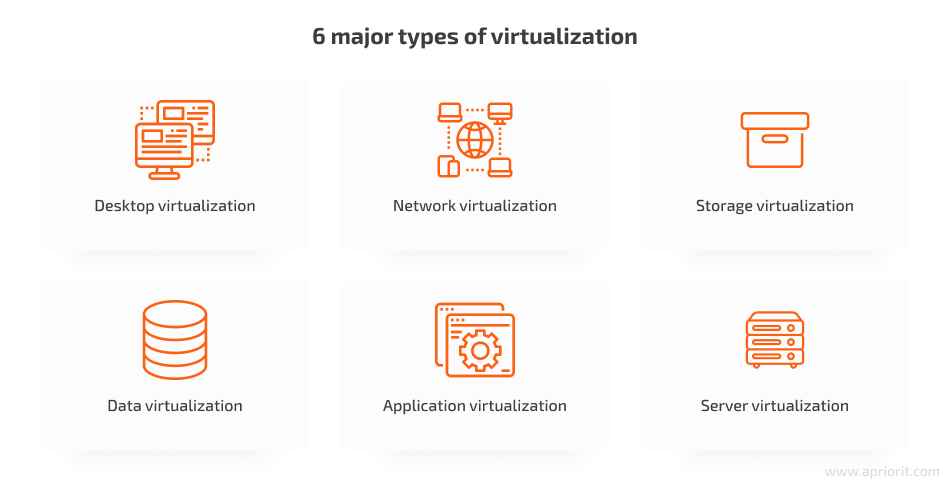Cloud computing and virtualization are the two main approaches organizations encounter when looking to optimize and modernize their IT infrastructure. However, to determine which will be the most suitable choice for your organization, you need to clearly understand how they work and how they differ.
The terms cloud computing and virtualization are often used in conjunction with one another and sometimes even interchangeably. In reality, they are very different concepts, each with its own set of pros and cons and designed to tackle different challenges.
In this article, we overview virtualization and cloud computing, explore their advantages and disadvantages, and summarize their similarities and differences.
Are cloud computing and virtualization the same?
Both virtualization and cloud services create environments from abstract resources, which is why these terms are sometimes used interchangeably. Before we explore each of these approaches in detail, let’s briefly outline their major characteristics to understand the basics of how they differ.
The key difference is that virtualization is a technology, while cloud computing is an environment.

Is virtualization necessary for cloud computing? Cloud computing uses server virtualization as an underlying part of the service, helping providers pool and deliver resources. If you already have a virtual infrastructure, you can expand it and turn it into a cloud. To do that, you’ll need to pool virtual resources, orchestrate them, and create a self-service portal for users.
However, while being prominently used as a part of cloud services, virtualization is not necessary for a cloud to exist and is not the equivalent of a cloud environment. Rather, modern cloud services are built on top of virtualization to deliver automation and scalability.
Let’s take a deeper look at these approaches, explore how they work, and discuss their pros and cons.
What is cloud computing?
Cloud computing is a methodology for delivering computer system resources and services like data storage and computing power from clouds on demand. Clouds are pools of virtual resources. They are orchestrated by management and automation software in a way that allows users to access them through self-service portals supported by automatic scaling and dynamic resource allocation.
All services and resources are hosted at a remote data center managed by a cloud services provider (CSP). A CSP provides the requested resources and bills them according to usage. Organizations often adopt cloud computing as part of a strategy to cut costs on maintaining and managing their own IT infrastructure, since they only pay for cloud resources used. This flexibility comes in handy if the required resources vary over time.
Cloud computing is a model for enabling ubiquitous, convenient, on-demand network access to a shared pool of configurable computing resources (e.g., networks, servers, storage, applications, and services) that can be rapidly provisioned and released with minimal management effort or service provider interaction.
Definition of cloud computing by NIST Special Publication 500-322 [PDF]
According to the National Institute of Standards and Technology (NIST), cloud computing has five essential characteristics, three service models, and four deployment models.
Let’s take a closer look at each of these, starting with characteristics:

- On-demand self-service. Customers can provision additional resources as needed by themselves via an automated system. Such a system shouldn’t require interaction with human administrators.
- Broad network access. Resources should be readily and fully available via the network, allowing users to access them from a wide range of client platforms.
- Resource pooling. Provided resources are pooled together and dynamically assigned based on consumer demand. From a customer’s perspective, resources should feel independent from hardware or physical location.
- Rapid elasticity. Resources should be able to appropriately scale according to user demand. From a consumer’s point of view, resources should feel unlimited, with the ability to quickly provision more at any time.
- Measured service. Resource use should be monitored and controlled, since users are usually charged as they go in proportion to the resources they are using.
Cloud computing can be delivered via a number of service models, each designed to answer different needs. The three most commonly used service models are:

- Infrastructure as a service (IaaS) offers computing resources such as processing power, memory, storage, or data center space. Users need to install their own software in order to use the provided resources.
- Platform as a service (PaaS) provides fully featured development environments to create applications. PaaS solutions often include operating systems, programming environments, servers, and databases.
- Software as a service (SaaS) provides access to applications on demand.
To fully understand how could cloud services work, we should learn the four main ways in which they can be deployed:

1. Public cloud services are offered via public networks, with data centers and infrastructure usually maintained by CSPs. While providers can limit access to their resources, they have no control over the set of users accessing their services. According to Gartner’s predictions, the market for public cloud services is forecast to grow 23.1% in 2021 to a total of $332.3 billion, up from $270 billion in 2020.
2. Private cloud services and resources can only be used within an organization. They are usually run and maintained by an organization and delivered via a secure internal network for internal needs. Private cloud services are quite expensive compared to other deployment types. In turn, they provide organizations with greater control over security, allow organizations to know where their data is located, and avoid the need to comply with requirements in multiple jurisdictions.
3. Community cloud services are created by several organizations in close proximity to address common challenges and concerns. Community clouds generally get the cost benefits of a public cloud while providing heightened privacy, security, and regulatory compliance.
4. A hybrid cloud uses at least two distinct deployment methods to create a specialized unified cloud service to answer an organization’s particular needs. A hybrid cloud could also mean a cloud service infrastructure for each set of cloud service customers (CSCs) that is virtually separated from the infrastructure of other CSCs.
Private and hybrid clouds are the first choice for most organizations from the security standpoint, while public clouds prove to be more cost-effective. Some organizations also use a multi-cloud approach, or an environment made up of several cloud services from several cloud vendors that can be public or private.
Cloud computing can be used to replace IT infrastructure fully or in part with a service that automatically scales on demand to cover all of a company’s computing needs without requiring the company to maintain their own staff and buy their own hardware. This makes cloud computing cost-effective and raises business efficiency, allowing companies to focus on their core offerings.
Benefits and challenges of cloud computing
As a segment of IT services, cloud computing has been growing, generating more than $300 billion in revenue in 2021. And businesses seem to keep adopting cloud infrastructure and services.
Let’s explore both pros and cons of cloud computing, starting with its top six advantages:

Cost efficiency. Cloud computing services are not cheap per se, but their pay-as-you-go pricing model allows organizations to wisely plan their infrastructure expenses. For example, an organization can easily expand their storage capacity in a few clicks whenever they need and don’t have to overpay for months when they don’t require that many resources.
Additionally, with cloud computing, businesses don’t purchase any physical hardware and don’t spend money on its installation, storage, configuration, and management.
Agility. With cloud computing, organizations receive more flexibility and accelerate their processes. For instance, you can deploy enterprise applications in minutes instead of waiting weeks for an IT team to review and approve your request, purchase hardware, and install software.
Also, by relying on a cloud vendor to take care of all infrastructure, storage, and hosting issues, your specialists can spend more time accomplishing business goals, optimizing the workflow, and improving customer service.
Scalability. Businesses significantly benefit from the elasticity provided by cloud services. Instead of purchasing excess storage units and hardware that remains unused during traffic declines, businesses can scale capacity up and down depending on current needs.
Mobility. Cloud computing allows your employees to access corporate data and resources via smartphones and laptops from anywhere in the world. In the post-Covid era, this mobility has become especially helpful for arranging efficient remote work.
Security. Every decent CSP carefully monitors the security of their services, striving to minimize the possibility of data breaches and other security incidents to maintain a good reputation. Businesses can use cloud computing infrastructure without worrying about managing basic cybersecurity procedures. Also, cloud services back up your data, allowing you to easily recover it in case something happens.
Visibility. Cloud-based systems ensure that all documents are stored in one place. With all employees accessing the same information, you can record any revisions or updates to documents, keeping data consistent and eliminating human errors and data duplication.
While the advantages of adopting cloud computing are obvious, a number of issues and challenges also exist, making life harder for both providers and clients:

- High expenses for enterprises. Affordability is one of the main advantages of cloud computing, but it becomes hard to maintain low costs as users pull more and more resources. Keeping cloud computing cost-effective for large companies is the challenge every service provider faces right now.
- Privacy issues. Privacy concerns are a prominent issue when it comes to cloud computing. Cloud computing is heavily monitored, with every user action known to the provider. Providers often handle personal user information that can be misused.
- Unavailability risks. If a cloud service becomes unavailable, users will be cut off from important data and computing resources. For a company, this can result in a loss of business. Therefore, ensuring high availability is a top priority for any cloud provider.
- Performance troubles. Lack of resources, bugs, or infrastructure flaws can result in poor performance that will harm the user experience.
- Poor reliability. Poor reliability due to synchronization issues, for instance, can severely disturb the user experience and lead to a loss of important data. Providers need to make sure their services are working as intended.
- Hackers and insider risks. Although cloud vendors keep an eye on service security, they still can’t guarantee flawless protection from severe hacking attacks. Also, cloud computing doesn’t secure corporate systems and data from negligent users and malicious insiders.
Now that we’ve covered major cloud computing pros and cons, let’s move to exploring what virtualization is alongside its advantages and drawbacks.
What is virtualization technology?
Virtualization is technology that allows you to create multiple simulated environments and virtual machines on a single physical computer or server. Gartner defines this technology as “the abstraction of IT resources that masks the physical nature and boundaries of those resources from resource users.”
Thanks to virtualization, organizations can run different operating systems, storage devices, computer-generated hardware versions, or applications while sharing the resources of a single host machine.
Virtualization is the abstraction of IT resources that masks the physical nature and boundaries of those resources from resource users. An IT resource can be a server, a client, storage, networks, applications or OSs. Essentially, any IT building block can potentially be abstracted from resource users
Definition of virtualization by Gartner
The core of virtualization is a hypervisor — a kind of emulator that can be computer software, firmware, or hardware. Hypervisors work either from within the operating system or on clean hardware. They are used to run several isolated virtual systems, often with fully simulated hardware, on a single physical machine. This allows, for example, for the placement of several virtual servers on a single physical server, allowing users to make their infrastructure more efficient.
Three key use cases of virtualization:

- Virtual machines are virtual environments that include a fully functional operating system. From a user’s standpoint, a virtual machine can appear indistinguishable from software installed on actual hardware. Virtual desktops and servers are prominent examples of this.
- Virtual resources technology is used to either divide a single physical resource into several virtual ones or, on the contrary, to pool several physical resources into a single virtual resource. Memory and storage are common targets of resource virtualization.
- Virtual applications are executed at the operating system level via the use of software containers, resulting in standalone software and databases that do not require installation and can run immediately.
While virtual resources and virtual applications are often used as part of a solution, virtual machines are used on their own to deliver controllable working environments and efficient advanced client–server architecture.
Virtualization was first developed as a means of dividing computing resources between several applications. Eventually, this technology grew to fully abstract software and hardware layers, making them independent from one another. Now almost every aspect of software and physical infrastructure can be abstracted and virtualized.
Just like in cloud computing, we can distinguish six major types of virtualization depending on the task:

- Desktop virtualization allows you to run multiple desktop operating systems on the same computer, each in its own virtual machine. It also allows a user to access their desktop virtually, from any location, via any machine.
- Network virtualization abstracts hardware elements and functions into software running on a hypervisor. In other words, network virtualization creates a “view” of the network that administrators can use to manage the network from a single console. Admins can modify and control infrastructure elements without touching the underlying physical components.
- Storage virtualization allows you to access and manage all storage devices on the network as a single device. This type of virtualization makes it easier to provision storage for virtual machines and make the maximum use of all available storage on the network.
- Data virtualization means that data is collected from various sources and managed in a single place, irrespective of source, format, or location. Data virtualization can help break down data silos when other types of integration aren’t feasible, desirable, or affordable.
- Application virtualization helps users gain remote access to an application from a server. It differs from desktop virtualization because only the application runs in a virtual environment, while the operating system on the end user’s device runs locally.
- Server virtualization masks server use. The physical server is divided into several virtual servers, and each can run its own operating system in an isolated manner. Server virtualization improves performance and reduces operating costs by deploying main server resources in a sub-server resource.
Read also:
Developing a Custom Remote Git Helper
Advantages and drawbacks of the virtualization approach
Apart from creating cost-effective IT infrastructure, virtualization benefits organizations in many ways. For example, it can be useful in software testing and development, product demonstrations, and training. You can also use virtualization in disaster recovery, since it allows you to deploy backups and additional resources in minutes.
Key advantages of virtualization:

- Efficient resource use. The computing power of modern servers is rarely utilized to its full extent. Virtualization allows you to place several virtual servers on a single physical one, allowing for effective server consolidation and full utilization of computing power. It also saves hardware resources and provides flexible easy-to-manage solutions that can be quickly provisioned as needed, allowing for cost-effectiveness and flexible, dynamic infrastructure.
- Hardware independence. With full virtualization, virtual software operates on virtual hardware specified by the user while being fully separate from the actual physical hardware of the host.
- Isolation. The operating system of a virtual machine is fully isolated from the OS of the host machine. Any changes made to the virtual OS will not be reflected on the host OS.
- Encapsulation. Virtual machines are fully encapsulated in a single file that’s easy to manage, back up, or move if needed.
- Redundancy. Several copies of virtual machines can be deployed on separate hardware to provide redundancy and ensure high availability.
- Minimal downtime. An application or system crash can cause downtime and disrupt your workflow. But with virtualization, admins can run multiple virtual machines alongside each other and switch between them if an issue arises. Running multiple physical servers would be much more expensive.
- Maximum uptime. Virtual machines can be deployed much faster than physical servers, making them a great tool to maximize uptime.
However, virtualization has some drawbacks:

- Costly initial investments. In the long run, virtualization brings efficiency and helps reduce operating costs. But in the beginning it requires significant investments. Adopting virtualization may be a challenge for small and midsize businesses that might not be capable of allocating funds for the required infrastructure in one go.
- Resource distribution. Once virtualization has partitioned systems, there’s a chance that some systems will function really well while others might not provide users access to enough resources to meet their needs. The problem of resource distribution often occurs in the shift to virtualization and can be fixed by working on capacity planning with your service provider.
- Server sprawl. Since a virtual server can be created in a matter of minutes, your employees may tend to create new servers too often without thinking of the consequences. Such server sprawl can cripple an otherwise healthy environment. Thus, it’s essential to look at how virtual machines are managed, who is doing what, and what systems are used.
- Backup issues. In a virtualized environment, there’s no actual hard drive on which data and systems can be backed up. You’ll have to configure additional tools for data backups that can make this process easier and allow backups to be stored in one place for easy tracking and access.
- Lack of automation and elasticity. Deployment or retraction of virtual machines is limited by hardware capabilities. You can’t simply add more resources beyond hardware limitations. There’s a limit for spending resources based on the necessity to maintain a certain minimum amount of hardware at all times regardless of your workload. Another issue is that resources can’t be automatically provisioned by the user as needed. You have to hire additional specialists to deploy, maintain, and retract virtual machines.
- Need for infrastructure. Ultimately, despite the presence of a certain level of abstraction, virtual machines are still part of an organization’s IT infrastructure. They require hardware maintenance and staff, and virtual machines themselves require a level of maintenance similar to that of physical machines.
Cloud computing and virtualization comparison
Both approaches can help businesses optimize their IT infrastructure. However, they don’t work in the same way and are supposed to help organizations meet different goals.
Here’s a concise comparison of virtual computing vs cloud computing:
| Virtualization | Cloud computing | |
| Definition | Technology | Environment |
| Core attributes |
|
|
| Applications |
|
|
| Use cases |
|
|
| Pros |
|
|
| Cons |
|
|
Cloud services are created with end users in mind. Instead of being part of a company’s IT infrastructure, they replace it with an automated on-demand service that does not require any management or specific knowledge from the organization using it.
This is what makes cloud services a completely different experience from the standpoint of companies both using and running the service. These key differences are also what distinguish these two concepts for a developer deciding to enter the market with their own solution.
Conclusion
Both virtualization and cloud computing can help your organization optimize its IT infrastructure in a convenient and cost-efficient way. Your choice should depend on your company’s goals, needs, desired infrastructure, and budget. You can also choose to use both. The reason why virtualization is important in cloud computing as foundation is automation and scalability it brings.
However, along with the wide range of benefits that cloud computing environments and virtualization technology can bring to your organization come some challenges. For instance, to properly build and manage your IT infrastructure, you need to find experienced and knowledgeable specialists.
At Apriorit, we have dedicated teams that provide cloud computing and virtualization development services, cloud platform engineering, and cloud infrastructure management services. Our professional developers are ready to help you create robust solutions in the cloud and virtualization domains according to your business needs. Contact us to start discussing your project right away!



